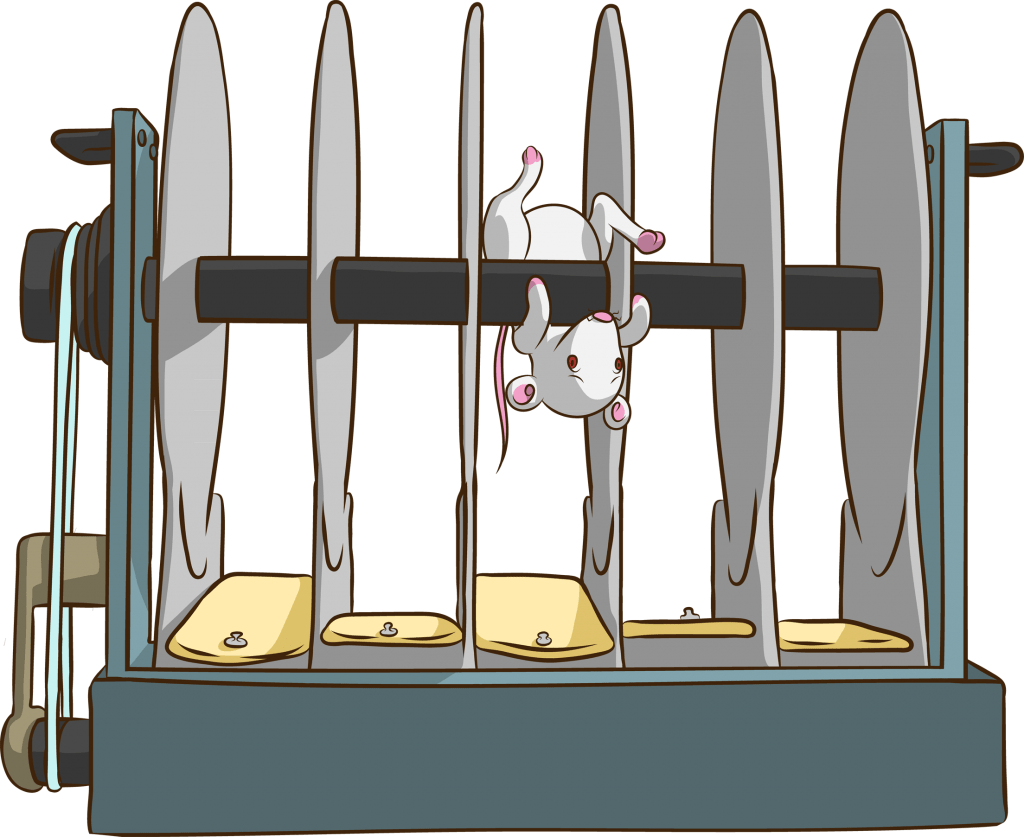Ask a neuroscientist what the rotarod test is useful for and the answer is likely to be straightforward: it’s a test of motor coordination. The rotarod test for mice is a great way to test for strength and balance (especially for screening side effects of drugs in preclinical tests). It also serves as a useful corollary test to run alongside other rodent behavioral tests.
Complex tasks, such as spatial navigation, rely upon a number of brain functions – including motor coordination. Thus, poor performance in strategy-based tasks (especially those indexing levels of activity), need to be carefully interpreted. When testing specifically for a mouse’s ability to successfully navigate through a spatial environment (such as in the Morris Water Maze task) it is important to disambiguate a spatial navigation deficit from what might actually be a motor deficit.
So What Exactly is The Rotarod Test?
In this test, the mouse is placed on a horizontal rod, which rotates about its long axis. At least two flanges prevent the mouse from leaving the rod. They are typically 30 cm in diameter (but this can vary) and are separated at 6 cm. The task of the mouse is to walk forward on the rotating rod (rotarod) without falling off. Importantly, the mouse must walk forward in order for a trial to be counted. Holding on to the rod but not walking results in “cartwheeling” and invalidates the trial.
Assessing Performance on The Rotarod Test for Mice:
On testing day, mice should be brought to the testing room and given 30 minutes to acclimate in their homecage. Once it is time to transfer the animal onto the rod, you can:
- Hold the mouse gently, bringing it close to the rod (and releasing when it’s very near to the slowly moving rod) or
- Transfer the mouse onto a dowel and then use the dowel to transfer the mouse onto the rod.
Ten seconds after the animal has been placed, you can adjust the speed of the rod rotation to the desired number. The next step is to note the speed at which the animal falls off of the rod. Two trials are run and two speeds are recorded. Depending on how soon after placement this fall occurs, different steps are taken. Specifically, if the mouse falls within:
- 1-4 seconds: Restart the trial (a latency this small indicates poor placement)
- 5-9 seconds: Note the trial but start again at “trial 1”
- After 10 seconds: Record speed (revolutions per minute or rpm) at which animal falls
Performance in the task is then calculated as the mean speed (rotations per minute or rpm) between the two trials. For example, if trial 1 was at 4 rpm and trial two was at 12 rpm then performance in the task for this mouse is calculated as (4 + 12 rpm) / 2 = 8rpm.
Potential Problems on The Rotarod Test for Mice?
Although the rotarod test for mice is a relatively straightforward task, there are still several parameters that need to be carefully considered in setup. For example, it is important that:
- The rod accelerates at an adequate speed (fast enough to be a challenge but not so fast that it grows into a test of endurance rather than a test of coordination)
- The rod is high enough above the base (typically 30 centimeters)
- The rod has ridges deep enough to facilitate grip but not so deep as to result in “cartwheeling”
- The start speed is adjusted (to 4 rpm) and accelerated up to 20 rpm/min
Notably, parameters must be adjusted according to the specific question at hand. For example, the motor deficit an animal normally shows in response to alcohol can be masked and go undetected if the speed of the rod is turned up too high. Thus, as with any rodent behavioral task, the output is only as useful as the calibrated parameters the experimenter puts in.
References:
Deacon, R. (2013). Measuring Motor Coordination in Mice Journal of Visualized Experiments (75) DOI: 10.3791/2609
Rustay NR, Wahlsten D, & Crabbe JC (2003). Influence of task parameters on rotarod performance and sensitivity to ethanol in mice. Behavioural brain research, 141 (2), 237-49 PMID: 12742261
Mouzon, B., Chaytow, H., Crynen, G., Bachmeier, C., Stewart, J., Mullan, M., Stewart, W., & Crawford, F. (2012). Repetitive Mild Traumatic Brain Injury in a Mouse Model Produces Learning and Memory Deficits Accompanied by Histological Changes Journal of Neurotrauma, 29 (18), 2761-2773 DOI: 10.1089/neu.2012.2498
Bohlen M, Cameron A, Metten P, Crabbe JC, & Wahlsten D (2009). Calibration of rotational acceleration for the rotarod test of rodent motor coordination. Journal of neuroscience methods, 178 (1), 10-4 PMID: 19041892

